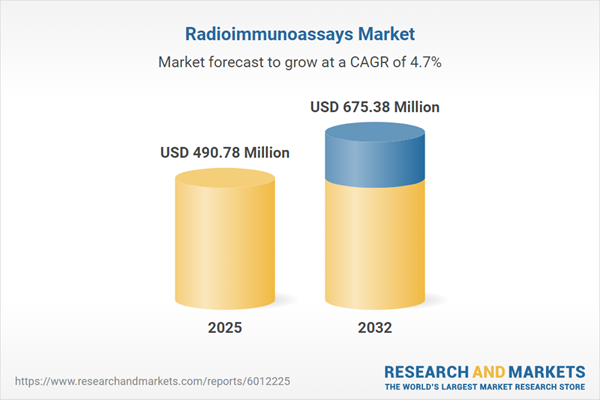Speak directly to the analyst to clarify any post sales queries you may have.
The Radioimmunoassays Market is undergoing significant transformation amid advances in assay technology, shifting regulatory frameworks, and evolving global supply chain strategies. Senior decision-makers face a rapidly changing landscape that demands informed, evidence-based strategies to unlock new growth opportunities and address operational risks.
Market Snapshot: Radioimmunoassays Market Growth at a Glance
The radioimmunoassays market grew from USD 468.61 million in 2024 to USD 490.78 million in 2025. It is expected to continue growing at a CAGR of 4.67%, reaching USD 675.38 million by 2032. Precision diagnostics and research demands are fueling this robust expansion as global healthcare and life sciences organizations invest in innovative analytical solutions to meet increasing clinical and operational needs.
Scope & Segmentation: Strategic Landscape Overview
This report provides in-depth analysis across multiple layers of the radioimmunoassays market. Segmentation factors include key product types, end-user categories, application areas, isotope choices, and geographic regions:
- Product Types: Kits (Multiplex, Single Analyte), Reagents (Antibody—Monoclonal, Polyclonal; Antigen)
- Applications: Clinical Diagnostics (Cardiology, Endocrinology, Oncology), Research (Academic Research, Pharmaceutical Research)
- End Users: Diagnostic Laboratories (Hospital Laboratories, Independent Laboratories), Hospitals (Private, Public), Research Institutes (Academic Institutions, Pharmaceutical Companies)
- Isotopes: Iodine-125, Iodine-131
- Regions: Americas (North America: United States, Canada, Mexico; Latin America: Brazil, Argentina, Chile, Colombia, Peru), Europe, Middle East & Africa (Europe: United Kingdom, Germany, France, Russia, Italy, Spain, Netherlands, Sweden, Poland, Switzerland; Middle East: United Arab Emirates, Saudi Arabia, Qatar, Turkey, Israel; Africa: South Africa, Nigeria, Egypt, Kenya), Asia-Pacific (China, India, Japan, Australia, South Korea, Indonesia, Thailand, Malaysia, Singapore, Taiwan)
- Companies Covered: Thermo Fisher Scientific Inc., PerkinElmer, Inc., Siemens Healthineers AG, Roche Diagnostics International AG, Abbott Laboratories, Beckman Coulter, Inc., DiaSorin S.p.A., Bio-Rad Laboratories, Inc., bioMérieux SA, Fujirebio Holdings, Inc.
Key Takeaways for Senior Leaders
- Radioimmunoassays remain integral to advancing clinical diagnostics and pharmaceutical research, supporting early disease detection and drug monitoring with high sensitivity.
- New assay design techniques and multiplexing facilitate simultaneous, high-throughput detection, streamlining operations and aligning with personalized medicine strategies.
- Rising operational complexity, particularly from international supply constraints, pushes organizations to strengthen supplier partnerships and diversify sourcing to mitigate risk.
- Product and application diversification enables targeted engagement with high-growth segments, such as oncology diagnostics and personalized therapy development.
- Regional market dynamics require adaptation; mature markets benefit from robust infrastructure, while emerging economies focus on upgrading healthcare resources and regulatory processes.
- Strategic collaborations among diagnostic vendors, academic centers, and pharmaceutical companies accelerate access to novel biomarkers and custom assay solutions.
Tariff Impact: Navigating 2025 Regulatory Changes
The introduction of tariffs in the United States in 2025 has increased production costs for radiolabeled isotopes and reagents, challenging supply chain continuity. In response, organizations are pursuing domestic partnerships and alternate procurement models, with streamlined approval pathways facilitating rapid adaptation. Adopting proactive supply chain resilience frameworks has become critical for minimizing disruptions and ensuring assay delivery reliability.
Methodology & Data Sources
The findings in this report derive from a rigorous methodology, including primary interviews with senior executives, scientific leaders, and procurement specialists, as well as secondary research using peer-reviewed publications and regulatory databases. Quantitative user surveys and review by subject matter experts underpin the reliability of these insights.
Why This Report Matters
- Gain actionable intelligence for capitalizing on emerging market segments and technology innovations.
- Navigate complex regulatory and supply considerations with confidence, informed by comprehensive segmentation and regional analysis.
- Support strategic planning with clear, validated recommendations grounded in robust industry and expert input.
Conclusion
This executive summary equips senior leaders with a strategic lens to evaluate investments, partnerships, and innovation priorities in the radioimmunoassays sector. Ongoing collaboration across stakeholders will shape future advancements and fuel sustainable market growth.
Additional Product Information:
- Purchase of this report includes 1 year online access with quarterly updates.
- This report can be updated on request. Please contact our Customer Experience team using the Ask a Question widget on our website.
Table of Contents
3. Executive Summary
4. Market Overview
7. Cumulative Impact of Artificial Intelligence 2025
Companies Mentioned
The companies profiled in this Radioimmunoassays market report include:- Thermo Fisher Scientific Inc.
- PerkinElmer, Inc.
- Siemens Healthineers AG
- Roche Diagnostics International AG
- Abbott Laboratories
- Beckman Coulter, Inc.
- DiaSorin S.p.A.
- Bio-Rad Laboratories, Inc.
- bioMérieux SA
- Fujirebio Holdings, Inc.
Table Information
| Report Attribute | Details |
|---|---|
| No. of Pages | 199 |
| Published | October 2025 |
| Forecast Period | 2025 - 2032 |
| Estimated Market Value ( USD | $ 490.78 Million |
| Forecasted Market Value ( USD | $ 675.38 Million |
| Compound Annual Growth Rate | 4.6% |
| Regions Covered | Global |
| No. of Companies Mentioned | 11 |









